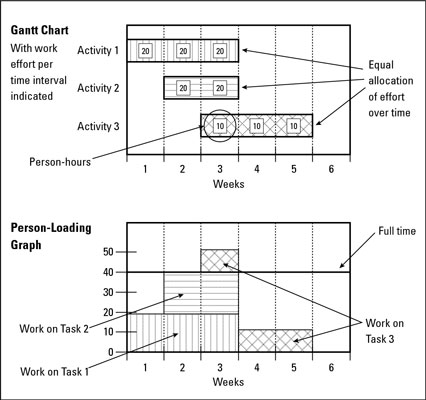Examining the workload of each member of the project team is the first step in making sure he or she can handle all project workloads. You can help them decide when they’ll work on each activity. If your initial plan has people working on more than one activity at the same time, your next task is to determine the total level of effort that needs to be devoted to each time period to meet those multiple commitments.
Begin planning out your workload by developing
A Human Resources Matrix
A Person-Loading Graph or Chart for each individual in the Human Resources Matrix
Suppose you plan to work on Activities 1, 2, and 3 of a project. The following table shows you plan that Activity 1 will take three weeks, Activity 2 will take two weeks, and Activity 3 will take three weeks. Table 6-2 also shows you estimate that you’ll spend 60 person-hours on Activity 1 (50 percent of your available time over the task’s three-week period), 40 person-hours on Activity 2 (50 percent of your available time over the task’s two-week period), and 30 person-hours on Activity 3 (25 percent of your available time over the task’s three-week period). If you don’t have to work on more than one activity at a time, you should have no problem completing each of your three assignments.
| Activity | Duration (In Weeks) | Work Effort (In Person-Hours) |
|---|---|---|
| Activity 1 | 3 | 60 |
| Activity 2 | 2 | 40 |
| Activity 3 | 3 | 30 |
The Gantt chart illustrates your initial schedule for completing these three activities. However, instead of having you work on these activities one at a time, this initial schedule has you working on both Activities 1 and 2 in week 2 and on all three activities in week 3. You have to decide how much effort you’ll put in each week on each of the three tasks to see whether you can work on all three activities as they’re currently scheduled.

As a starting point, assume you’ll spend your time evenly over the life of each activity. That means you’ll work 20 hours a week on Activity 1 during weeks 1, 2, and 3, 20 hours a week on Activity 2 during weeks 2 and 3, and 10 hours a week on Activity 3 during weeks 3, 4, and 5.
Determine the total effort you’ll have to devote to the overall project each week by adding up the person-hours you’ll spend on each task each week as follows:
In week 1, you’ll work 20 person-hours on Activity 1 for a total commitment to the project of 20 person-hours.
In week 2, you’ll work 20 person-hours on Activity 1 and 20 person-hours on Activity 2 for a total commitment to the project of 40 person-hours.
In week 3, you’ll work 20 person-hours on Activity 1, 20 person-hours on Activity 2, and 10 person-hours on Activity 3 for a total commitment to the project of 50 person-hours.
In weeks 4 and 5, you’ll work 10 person-hours on Activity 3 for a total commitment to the project each week of 10 person-hours.

